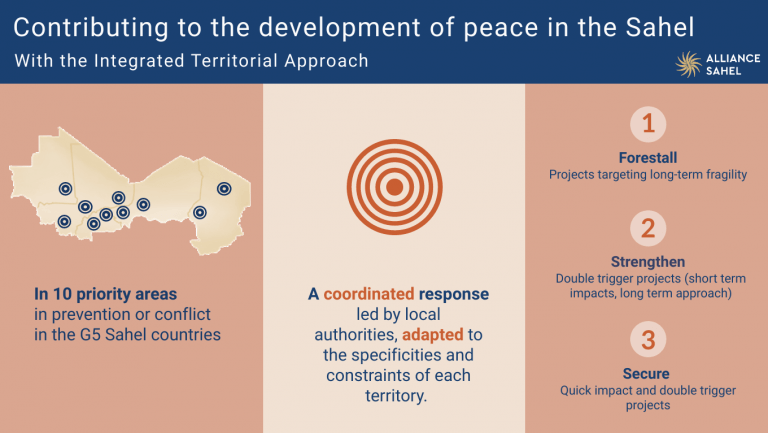Tools to facilitate the implementation of the integrated territorial approach
The commitments made at the first General Assembly of the Sahel Alliance on 25 February 2020 commited the need for better coordination of efforts at field level and for geographical coherence of members’ actions. It was recommended to promote a differentiated approach to fragile areas thanks to an integrated territorial approach (“Approche Territoriale Intégrée”, ATI).
This approach aims to articulate a coordinated response by actors, supported by the authorities of partner countries and consistent with the reality on the ground, the needs of the populations and local, regional and/or national strategies, in order to create the conditions for a sustainable exit from the crisis in the Sahel. Ten priority areas have been identified in order to implement this approach.
An Integrated Territorial Approach database (BD ATI) has therefore been developed as a geographic information system to support decision-making in the priority areas of the Sahel. This is currently available for the full member organisations of the Sahel Alliance.

The ATI database allows the monitoring and centralisation of geolocated data on activities financed by Sahel Alliance members in priority areas, as well as the centralisation of contextual data that provide an overview of the situation and needs in the G5 Sahel countries.
Maps for a better representation of needs
The data can be visualised in a cartographic way. By cross-referencing the needs identified on the ground with the responses provided by the Sahel Alliance members, it is possible to determine the needs that are not yet covered on the ground as well as any necessary re-orientation of ongoing support. The aim is therefore to offer responses that are in line with the needs of the populations benefiting from the actions of the Sahel Alliance members.
These data were updated in January 2023, thanks to the contribution of the full members of the Sahel Alliance (activity data) and the mobilisation of five local consultants to collect contextual data in the field. At present, 19,000 activity data and 115,000 contextual data can be consulted on the ATI database.
How to get access to the ATI database?

Each full member organisation nominated a focal point to validate the creation of access for up to 10 people from their organisation. The persons granted access are responsible for respecting the established rules of confidentiality and data sharing. The persons wishing to obtain access can contact melissa.montarou@giz.de and nina.perruchet@giz.de to identify the focal point within their organisation.
Go further

